|
Cooking gear
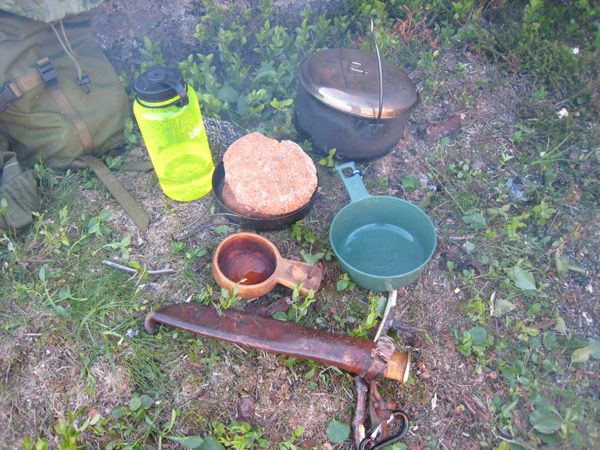
You don’t really need a lot of cooking gear with you.
If you are alone you only need one pot to cook everything.
The cheapest and easiest pot one could obtain/make is an empty can of hermetic food or a coffee can. Just cut the "lid" completely off and beat the sharp edge down with a hammer, rock or use the back of your knife to smooth it. A piece of fence wire could be used as handle.
Most of these cans hold about a litre of fluid although other sizes are also found. You could then cover it with cooking oil and burn it, but I usually just use it as is. The thick black covering will come after use.
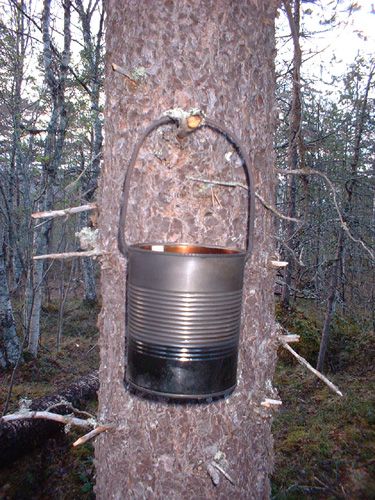
The picture above left shows one of my "coffee cans" after the first use. It is now all black of soot. This cover protects the can from rusting.
Another cooking vessel I obtained very cheap is an aluminium military mess kit (picture below).
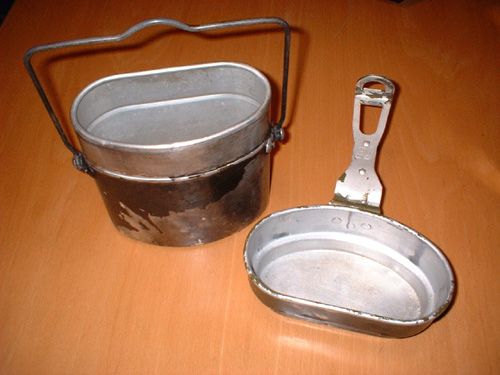
They cost around 30-40 NOK in army surplus stores. Their shape is a little odd but they work great, I have three of them. In the army there was an internal cup as well, but none of my civilian bought items has this cup.
One of their forces is that one could actually store a stew in them under transport as the lid is "air tight".
The drawback with these pots is that they are harder to clean properly than a wider round pot, wich I prefer.
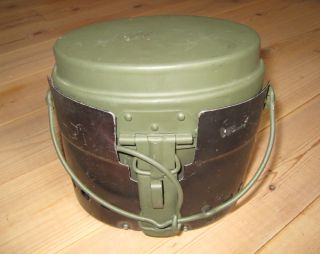 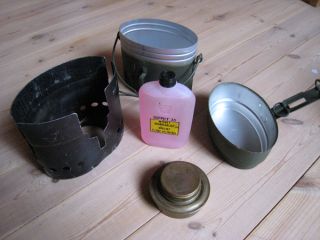
The Swedish army even have stoves (alcohol) for this type of cooking vessel. I also have one of these (pictures above). I bought it in a second hand store for 50 NOK. I couldn’t see any marks of use on it. While these "trangias" don’t impress me with speed or cold weather use they are still neat, and I know many swear to them.
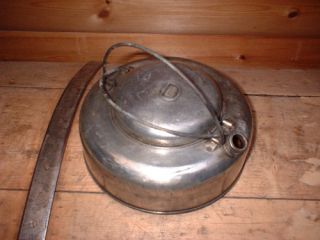
Some like carrying a pot just for brewing tea or coffee (picture above). I bought mine at a Salvation Army store for 20 NOK several years ago.
Mine is made from iron and rusts if not dried after use, but new ones of same model is made of stainless steel. I only use it for cooking water, making tea or coffee, but I know Lars Monsen (Norwegian wilderness guru :) use only a coffee pot for everything he makes. I think this sound very messy, but it could be worth a try.
I use a stainless steel pot of 3.9 litres and a stainless steel frying pan when out in the wild (picture on top of page).
The frying pan packs inside the steel pot. These are from different sets made by Eagle Sharp. Stainless steel doesn’t burn when empty thus making them good for making bread on the fire. Sort of a Dutch oven, see below.
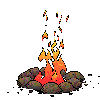 Using the cooking your pots as an oven Using the cooking your pots as an oven
Some of you would probably have noticed that I haven`t written anything about pot stands or hangers. That’s because I seldom use them.
I mostly just place my pot in or by the fire.
By placing the pots by the fire it may take longer time to cook the food but I`m not in the woods setting world records, quite the opposite.
Occatinally I do make a pot hanger.
I mostly use a stick set firmly in the ground at the right angel and suspend my cooking vessels from it. If the pot is too heavy or I want to adjust the height I support the stick with a stone or a Y shaped branch.
Storing your pots and kettles
A bag for storing the cooking vessels in for transport is a must if you don’t want your rucksack to become full of soot.
It doesn’t matter if it is leather or cloth.
Just remember, a leather bag will shrink if a hot cooking vessel is put in it. The cloth bag will not be affected by a hot cooking pot. I have made cloth bags for all my cooking pots.

A plastic grocery bag will also do allthough it will be badly affected if you put a hot pot in it.
Stoves
I mostly rely on wood fires for cooking and warmth, but occationally one go outside the wooded area and a stove is necessary, especially in winter time.
Below is a link to a page containing info of the stoves I use.
 Stoves I use Stoves I use
Cups
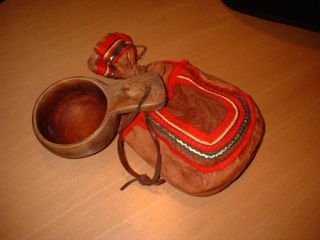
I prefer to use a wooden cup or kuksa (above pic.) in the wild.
I know that metal is light and durable but it is something with metal and cold I don’t like. Maybe it is the thought of my tongue glued to the outer stairs very cold metal railing :).
 Making a wooden cup Making a wooden cup
There are also other cheap cups that will function very well in the wilderness. The two cups on the picture below are decent cups for the woodsman. The green plastic one I bought in Sweden for 19 NOK and the metal one is a cup from a US army canteen from WWII.
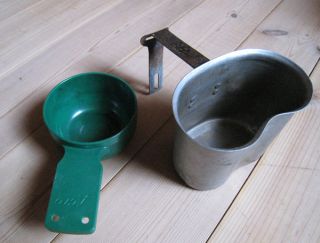
Another cup I can recommend is a Swedish foldable cup. It is the size of an ordinary coffe cup, but folds down to half the size (picture below,left). It fits in the jacket pocket and it is real handy.
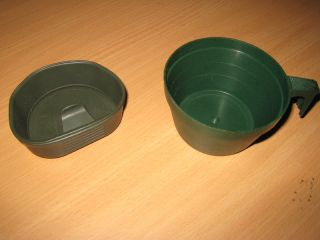
They are also cheap to buy.
Just remember that plastic is harder to keep clean on the trail than wood or metal.
Spoons and other eating implements
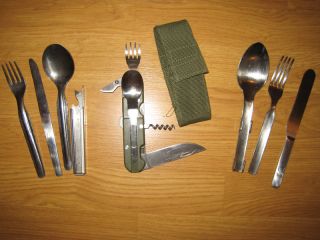
Most of us probably bring along a spoon, or even a full set containing knife, fork and a spoon.
I have tree sets of cutlery for the field. One is from the former East German army, one from the Norwegian army and a third from Eagle Sharp wich basically is a folding knife with a spoon and fork attached.
The East German consists of a spoon, knife and a knife. Everything is hold together during transport by a metal holder wich doubles as a can opener. I bought it very cheap in the early 90`s and I don`t know if they are available anymore.
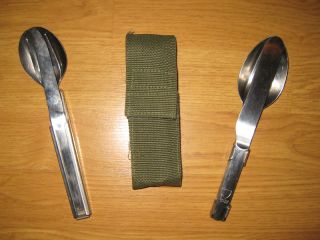
On the Norwegian model the knife and fork is attached to two lugs on the spoon. This set is quite heavy, and therefore I like the German set better.
But it is at least built to last. The spoon is also quite big and is excellent for stirring stews.
But occationally one forget to pack these items, something one usually don`t know about until just before you make your lunch or dinner.
 Making your eating tools in the field Making your eating tools in the field
Food containers
I use many different types of containers for my food stuff. Usually it depends on the length and nature of the trip.
When out on a daytrip I usually just have a leather bag with coffee with me. On longer treks I may use several other containers as well, containing the food I going to eat.
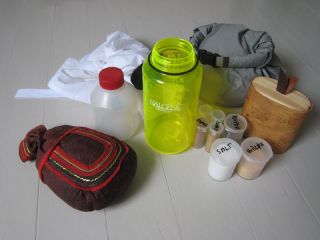
Flour I usually pack in a plastic zip lock bag with a cloth bag cover for additional strength.
I store sugar in a homemade birch bark box.
 Homemade birch bark box Homemade birch bark box
I use a small drinking bottle (something from a bottle belt that joggers use?) for cooking oil.
I am also fond of lexan bottles, and I have several of them. They are hard wearing, water proof and fairly light weight.
Mostly I pack the food containers in a grey dry sack, which I then stuff in my rucksack. That way I have my food stuff in one place. Besides the dry sack keeps my food dry if I fall into a creek or lake.
While the containers and content may vary, I always store my coffee grounds in a leather bag. The bag is made of bark tanned Reindeer hide.
I bought it several years ago from a Sámi woman who had both tanned the hide and sewn the bag herself.
The bags are not usually as “flamboyant” as mine, but I bought the most “tourist item” like bag I could find.
I’ve later tanned a reindeer hide myself, and sewn a bag just like it, and it was a lot of work. My bag isn’t as soft as my bought issue, but that is due to my laziness.
 Making a leather coffee bag Making a leather coffee bag
|